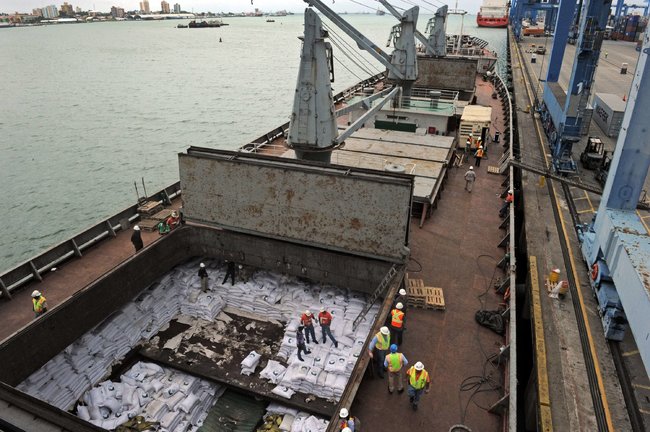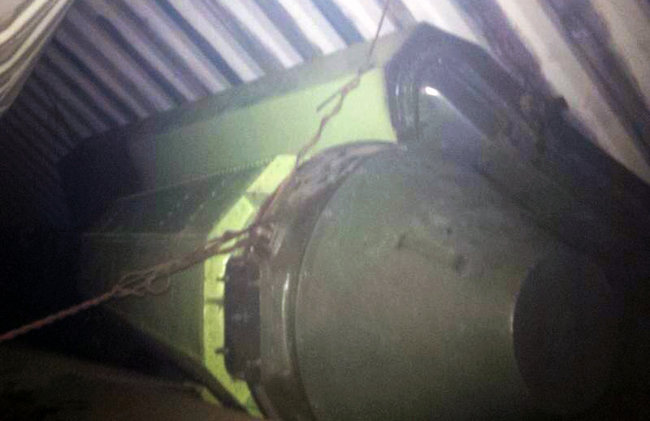As reported in a New York Times article, a North Korean ship was seized in Panama carrying more than a sweet cargo of sugar. Go Panama!!
It started with a tip: that a rusty North Korean freighter, which had not plied the Caribbean in years, was carrying drugs or arms amid more than 200,000 sacks of Cuban brown sugar.
It ended with a five-day, eventually violent standoff between Panamanian marines and 35 North Korean crew members, armed largely with sticks, who were subdued and arrested while their captain, claiming he was having a heart attack, tried to commit suicide.
 Got to imagine this as actually happening!!
Got to imagine this as actually happening!!
Underneath all that sugar, it turned out, were parts for what appeared to be elements of an antiquated Soviet-era missile radar system that was headed, evidently, to North Korea — a country that usually exports missile technology around the world, rather than bringing it in.
Late Tuesday night, Cuba’s Ministry of Foreign Affairs issued a statement saying the cargo stashed in the vessel, the Chong Chon Gang, consisted of “240 metric tons of obsolete defensive weapons” bound for North Korea, where it was to be repaired and then sent back to Cuba.
But American and Panamanian officials were still trying to understand why the ship’s crew had fought so hard to repel a boarding party as the ship tried to traverse the Panama Canal. After all, the equipment they were protecting would make a nice exhibit in a museum of cold war military artifacts. “We’re talking old,” one official briefed on the episode said. “When this stuff was new, Castro was plotting revolutions.”
The Cuban Ministry did not seem to be offended, describing the equipment to be repaired as “two antiaircraft missile complexes, Volga and Pechora; nine missiles in parts and spares, two MiG-21bis and 15 motors for this type of airplane, all of it manufactured in the mid-20th century.”
The episode also offered a window on the desperate measures North Korea is taking to keep hard currency and goods flowing at a time when its ships are tracked everywhere, old customers like Syria and Iran are facing sanctions and scrutiny of their own, and its partners have dwindled to a few outliers.
Still, Cuba’s role was puzzling — at a time when Washington has talked of relaxing restrictions and Cuba’s leadership has seemed more eager to improve its ties with the West than to strengthen relations with cold war-era partners.
Even by the measure of bizarre stories about North Korea’s black-market dealings, the events of the past five days in Panama set some records. In recent times North Korean shipments to Myanmar and the Middle East have been tracked and in some cases intercepted, a testament to how closely American spy satellites follow the country’s aging cargo fleet.
“What I can say for sure is that looking at illicit North Korea trade, their ships in particular, these guys are stumped for money, they are incredibly poor,” said Hugh Griffiths, an arms trafficking specialist at the Stockholm International Peace Research Institute. “Business deals that might look silly to us don’t look ridiculous to them.”
Panama’s president, Ricardo Martinelli, announced the discovery in a radio broadcast on Monday night, making it clear that the North Korean ship was in blatant violation of numerous United Nations sanctions. He even posted a photograph of the contraband on his Twitter account.
Based on that picture, IHS Jane’s Intelligence, a defense consultancy, identified it as an SNR-75 “Fan Song” fire control radar for the SA-2 family of surface-to-air missiles. The component is important for guiding a missile to its target; the Soviets began building similar systems in the mid-1950s, well ahead of the Cuban missile crisis.
In a statement, IHS Jane’s speculated that the system was headed to North Korea for an upgrade, and that “the cargo of sugar could be a payment for the services.”
But it also said the radar equipment could have been en route to North Korea to augment that country’s air defense network, which it said was based on obsolete weapons, missiles and radars.
That raised the possibility that other elements of the shipment were aboard, or on other ships.
“We’re going to keep unloading the ship and figure out exactly what was inside,” Mr. Martinelli said. “You cannot go around shipping undeclared weapons of war through the Panama Canal.”
There was no comment on Tuesday from North Korea on the vessel’s seizure.
The Chong Chon Gang, a 36-year-old freighter, has its own peculiar history, and this was not the first time the vessel had encountered run-ins with maritime authorities. It was stopped in 2010 for carrying narcotics and ammunition, Mr. Griffiths said. He also said it had been attacked by Somali pirates.
According to IHS Fairplay, a London-based vessel-monitoring service, the freighter had not traveled the Western Hemisphere in at least four years. The monitoring data shows that it visited Panama in 2008 and Brazil in 2009.
Mr. Griffiths noted that its reappearance, even with the cover of a Cuban cargo of sugar, was bound to attract attention. He said interest in the vessel’s itinerary in recent weeks, which included a stopover in Havana, might have been heightened because of the July 3 visit to Cuba of North Korea’s top military commander, who conferred with President Raúl Castro. Cuban and North Korean news media publicized the trip.
“There are very few states where the North Korean chief of staff is welcomed for a high-level meeting,” Mr. Griffiths said.
American spy satellites regularly track North Korean vessels — but usually to stop weapons proliferation, not drugs. And as the intelligence agencies discovered several years ago, failure to monitor can lead to other lapses: the United States missed the construction of a North Korean nuclear reactor in Syria until Israeli officials brought evidence of it to Washington in 2007. Israel destroyed the reactor later that year.
Matthew Godsey, editor of the Risk Report, a publication of the Wisconsin Project on Nuclear Arms Control, a proliferation research group in Washington that follows North Korean behavior, said the Chong Chon Gang might have also been able to travel in the region undetected in the past by turning off its satellite transponder, used by tracking services to monitor vessels for their own safety.
“I think North Korean vessels have been known to do that,” he said. “It’s dangerous, but when you’re carrying dangerous stuff it can happen. When you have a captain willing to kill himself, it wouldn’t surprise me.”
Mr. Martinelli and other Panamanian officials said the vessel’s 35 crew members were taken into custody on Sunday after they violently resisted efforts to redirect the vessel to the Panamanian port of Manzanillo, at the Atlantic end of the canal. He did not explain how the captain sought to commit suicide, and the captain’s condition was unknown.
José Raúl Mulino, Panama’s minister of security, said in a telephone interview that the entire crew had been detained at a naval base after committing what he called an act of “rebellion and sabotage” in trying to resist the boarding of the vessel. It was unclear whether they would face criminal prosecution or be sent back to North Korea.
Mr. Mulino said that the suspect cargo was hidden in two containers behind the sugar, and that all 220,000 to 230,000 sugar sacks aboard would be removed before the ship could be completely investigated. The process can take a while, he said, because the crew had disabled the unloading cranes, forcing the Panamanians to remove the bags by hand.

